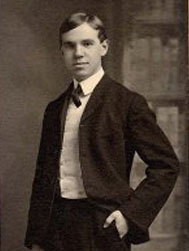Charles Tomlinson Griffes facts for kids
Charles Tomlinson Griffes (born September 17, 1884 – died April 8, 1920) was an American composer. He wrote music for the piano, for small groups of instruments called chamber ensembles, and for singers.
At first, his music sounded like German Romanticism. But later, he found his own style. He became known for Impressionism in American music. This style uses sounds to create a mood or picture. Griffes loved the mysterious sounds of French Impressionist music. He also studied music by Russian composers like Scriabin. Their influence can be heard in his unique musical scales.
Contents
Griffes's Musical Journey
Griffes was born in Elmira, New York. He started learning piano early from his sister. Later, he studied with Mary Selena Broughton. She was a teacher at Elmira College. Broughton greatly helped him grow as a person and a musician.
After studying piano and organ, he went to Berlin. He studied piano at the Stern Conservatory. Even though he was a good performer, Griffes became more interested in writing music. He briefly studied with the composer Engelbert Humperdinck. While in Berlin, he wrote several German songs. He also composed a large orchestral piece called Symphonische Phantasie.
When he returned to the U.S. in 1907, he took a job. He became the music director at the Hackley School for boys. This school is in Tarrytown, New York. He kept this job until he died thirteen years later. This job gave him a steady income. He used his free time to compose music. He also worked to share his music during the summer.
Famous Musical Works
Griffes created many well-known pieces. His most famous works include:
- The White Peacock: This was first for piano in 1915. He later arranged it for an orchestra in 1919.
- His Piano Sonata: He wrote this important piano piece between 1917 and 1918. He revised it in 1919.
- The Pleasure Dome of Kubla Khan: This is a tone poem. A tone poem is a piece of music that tells a story or describes a scene. It was inspired by a poem by Coleridge. Griffes wrote it in 1912 and revised it in 1916.
- Poem for Flute and Orchestra: He wrote this piece in 1918.
He also wrote many other pieces. These included works for piano, chamber groups, and singers. It is amazing how much good music he wrote. He had a short life and a full-time teaching job. Many of his pieces are still performed today.
One of his early works was Sho-jo (1917). This was a short play without words, called a pantomimic drama. It was based on Japanese themes. It was one of the first American pieces directly inspired by Japanese music.
Griffes's Life and Legacy
Charles Griffes died young, at age 35. He passed away from influenza in New York City. This happened during the worldwide Spanish Flu pandemic. He is buried in Bloomfield Cemetery in Bloomfield, New Jersey.
Griffes kept detailed diaries. These diaries recorded his musical achievements. They covered the years from 1907 to 1919.
Musical Compositions
Charles Griffes wrote many different kinds of music. Here are some examples of his works:
Stage Works
These pieces were written for performances on a stage, often with dancing or acting.
- The Kairn of Koridwen (1916): A dance drama.
- Sho-jo (1917): A Japanese pantomime.
- Sakura-sakura (around 1917): An arrangement of a Japanese folk dance.
- The White Peacock (around 1919): A ballet version of his piano piece.
- Salut au monde (1919): A drama based on a poem by Walt Whitman.
Orchestral Works
These are pieces for a full orchestra.
- Symphonische Phantasie (1907)
- The Pleasure-Dome of Kubla Khan, Op. 8 (1917): A famous tone poem.
- Poem, for flute and orchestra (1918)
- Bacchanale (around 1919): Based on an earlier piano piece.
- Clouds (around 1919): Also based on a piano piece.
- The White Peacock (around 1919): An orchestral version of his piano work.
Chamber Music
This music is for small groups of instruments.
- Three Tone-Pictures (1915): For woodwinds and harp. These include "The Lake at Evening" and "The Vale of Dreams."
- Two Sketches based on Indian Themes (1918–19): For string quartet.
Piano Music
Griffes wrote many pieces for solo piano.
- Three Tone-Pictures, Op. 5 (1910–12): Includes "The Lake at Evening" and "The Night Winds."
- Roman Sketches, Op. 7 (1915–16): Includes "The White Peacock" and "Clouds."
- Sonata (1917–18): A major work for piano.
- The Pleasure-Dome of Kubla Khan (1912): Also a piano version.
Organ Music
He wrote one piece for the organ.
- Chorale on "O Haupt voll Blut und Wunden" (1910)
Songs
Griffes composed many songs for voice and piano.
- Tone-Images, Op. 3 (1912–14): Songs based on poems by Oscar Wilde and W. E. Henley.
- Four Impressions (1912–1916): More songs based on Wilde's poems.
- Three Poems, Op. 9 (1916): Including "Waikiki."
- Five Poems of Ancient China and Japan, Op. 10 (1916–17): A well-known collection of songs.
- Three Poems of Fiona MacLeod, Op. 11 (1918).
- Many German Songs (around 1903–1909).
Choral Works
These pieces were written for choirs to sing.
- Passionlied (1906)
- Lobe den Herren (1906)
- These things shall be (1916)
See also
 In Spanish: Charles Tomlinson Griffes para niños
In Spanish: Charles Tomlinson Griffes para niños


